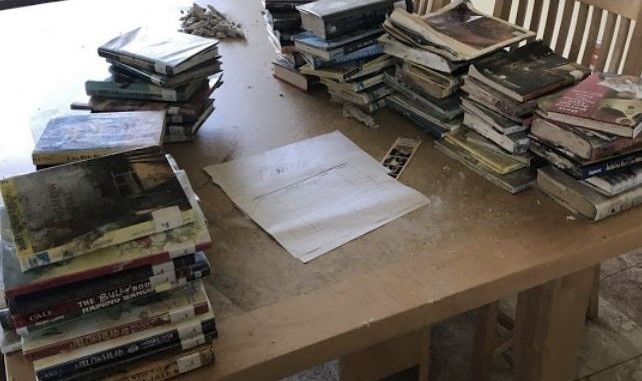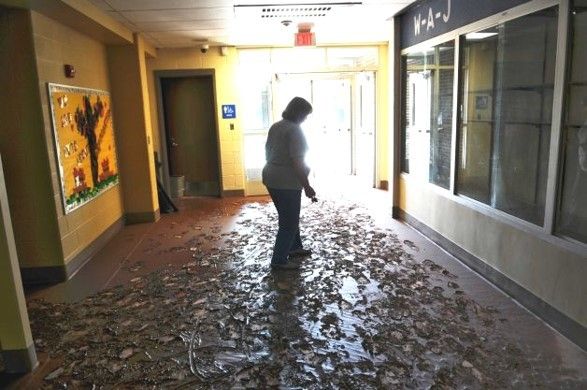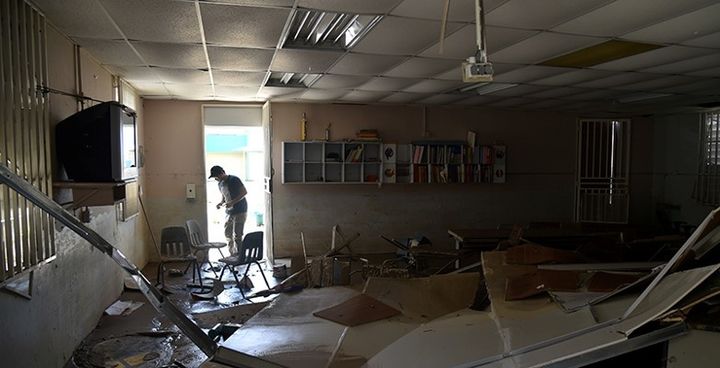School classrooms with mud-covered floors and damaged furniture piled all around. Public school grounds inundated with flood water, some of it contaminated with toxics released by overflowing sewers of flooded brownfield sites. A damp pile of moldy text books. Children evacuated as wildfires threaten. And schools closed for more than a full month of classes. These are just a few of the dangerous situations recently faced by schools and by children from California, to Texas, Florida, Puerto Rico and the Virgin Islands as the impact of hurricanes, floods and fires are felt across the country.

Moldy Schoolbooks: U.S. Virgin Islands
The U.S. has never seen a sequence of natural disasters consistent with the predicted impacts of a changing climate to rival the recent spate of calamitous storms. And for children, the impacts are magnified. It’s not just that children are more susceptible to toxic hazards, heat, fire and flood. They are required, by law, to be in their classrooms if schools are open. Yet there are no regulations or public health policies to guarantee that a disaster-damaged school won’t reopen until it is has been assessed as safe for children.

Mud coats the floors of the Windham Ashland Jewett Central School, damaged as a result of Tropical Storm Irene, on Wednesday Aug. 31, 2011, in Windham, NY. Michelle Mattice, treasurer of the school district, walks through the hall.
In New York, after Superstorm Sandy five years ago, the state told school leaders statewide that buildings could re-open if they met just three basic criteria: normal electric power; potable water and functioning toilets; and the ability to communicate with the outside world. That’s all, according to a New York State Education Department field memo issued Nov. 6, 2012. Nothing about the level of cleanup, salt-water damage to electrical systems, elimination of mold or toxics or addressing the impact of contaminated ground water. Can you imagine the pressure on hard hit communities struggling to return to normal to reopen the schools and get the kids back in the classroom?
But it’s even more complicated. In some communities bracing for the impact of on-coming storms, schools become community centers, places of refuge, or at least buildings where families can gather to wait. Large buildings, often in poor repair, that were never designed as shelters, are suddenly faced with these new responsibilities.
If the past two months are an indication of what is to come, parents, educators, and government officials need to take a long hard look at what is really going on. Children’s environmental health and safety are clearly not a national priority or even state priorities. And under what is becoming the least-child-friendly administration in Washington ever, investments in our children’s future are being scuttled.
A national summary report finds that in the past five years, the number of children in PreK-12 public schools has grown. So has the number of children living in poverty, as measured by school lunch eligibility and the number of children with preexisting health or learning problems. But the number of staff have decreased. We are failing our children every day, especially in the face of ever-stronger climate events.
Let’s take a look at some of the climate-related particulars children face.
We need to be careful about some of the accepted adaptations or remedies that may fail to grasp the whole picture. Buildings that are sealed to reduce heating and cooling costs, also lower ventilation (fresh air), increase humidity and increase exposure to VOC off-gassing. It can also increase classroom carbon dioxide (CO2) levels, decreasing alertness and critical thinking skills. Test scores drop in failed indoor environments, and also drop in too hot classrooms.
Increased use of air conditioning, if not well maintained, leads to systems that often have microbial growth, and dampness-related problems. Facility renovations and repairs of older buildings disturb hazardous building materials like PCBs, lead, and asbestos, increasing indoor and outdoor toxic air pollution.

Classroom damaged by Hurricane Maria in Puerto Rico.
And let’s not forget the most vulnerable populations. Communities of color, low income, immigrants and limited English proficiency characterize neighborhoods that have faced some of the most dramatic climate impacts, with the least ability to finance facility repairs or adaptations, or even protect themselves.
Here are a few conclusions for forward-looking federal and state policymakers to protect children in schools and in child care centers.
First, of all, never allow children to be part of household or community disaster clean ups: there is simply no PPE (personal protective equipment) designed for kids and beside they are more vulnerable to hazards than the adults around them.
Further, responsible health, education, environment, and energy agencies must be part of the climate dialog. Education departments should be far more aware of school facility vulnerabilities and the impacts on children, especially from the climate impact point-of-view. Extra thought should be given to designating local schools as disaster-area shelters. Health and education and other responsible departments and agencies and departments should disseminate public health advisories pre- and post-disasters on how to prevent harm to children in school or on returning to disaster-damaged schools. And FEMA’s emergency funds should not ever be misused in a way that effectively demolishes neighborhoods and the public education system, or used to rebuild educational facilities for children on hazardous sites.
Tip for parents and others concerned about children: watch the weather advisories and watch the public health advisories. If your child’s school or child care center has been flooded, had chemical spills, or been otherwise damaged, what is in place today to ensure that the facility will be safe for your child to re-occupy tomorrow?